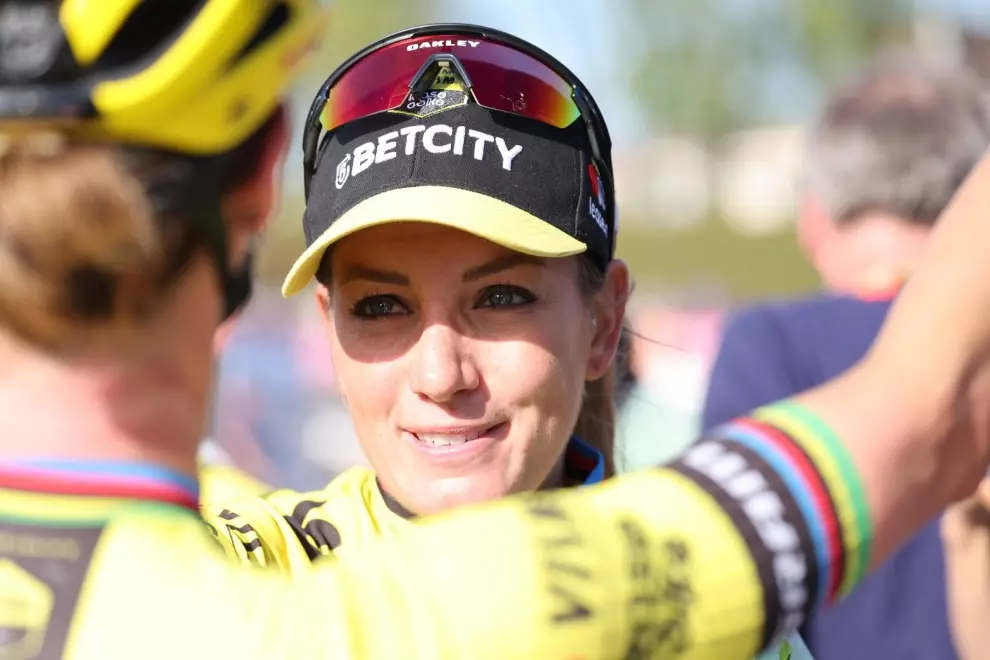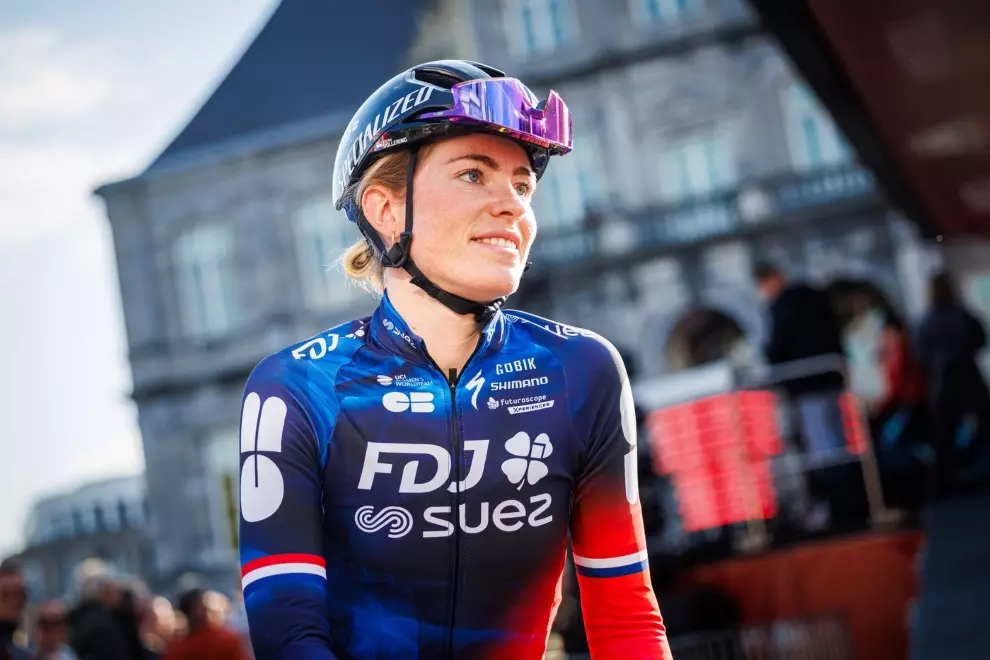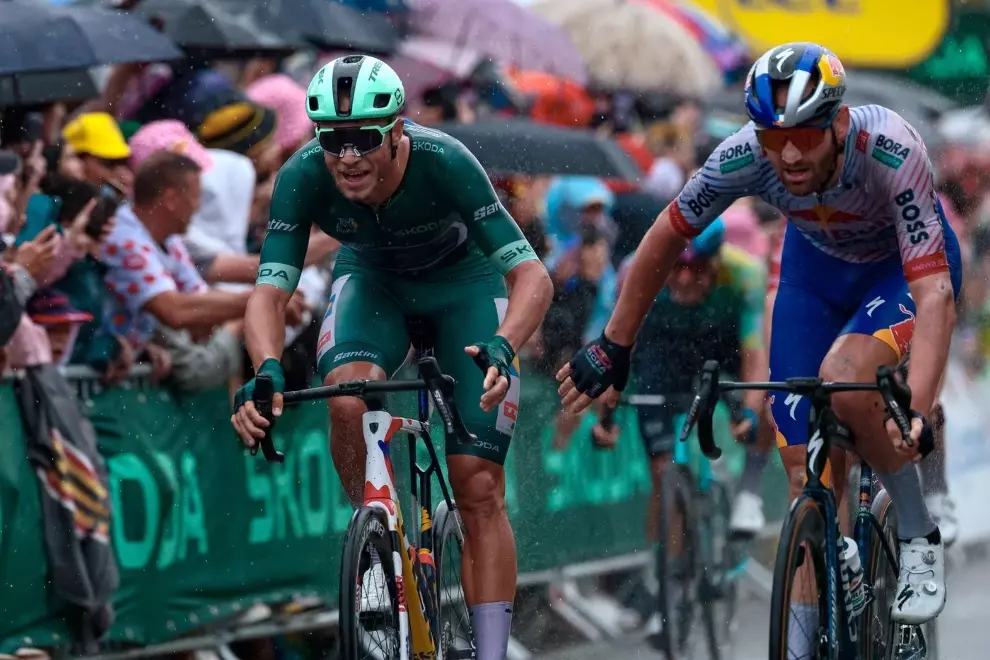With a little more than 20km left to ride in Thursday’s stage 5 of the Critérium du Dauphiné, as the peloton was chasing a three-man breakaway, more than two dozen riders crashed heavily on a flat, straight, harmless-looking stretch of road that had been made slippery as ice by rain. Wisely, organizers wasted little time in annulling the rest of the stage. [See the crash HERE.]
“What happened, I think, guys in fifth, sixth position started to touch the wheel and just slid away, and after that it was like bowling,” Evenepoel told journalists. “I just went like a front-flip and landed on my head and shoulder. A pretty big bang but nothing too special.” He was fortunate, as was the other co-favorite for the race, Primož Roglič (BORA-hansgrohe), who also hit the pavement. Both are staying in the race.
The Slovenian was also upset after the incident. “I crashed on my shoulder, it’s not the best; it’s the side I had surgery on a few years ago,” he said. “We need to check it and see what kind of a state it is in. For me definitely a lot better than some of the guys. I still rode over the finish.”
Evenepoel and Roglič are just coming back to racing after recovering from injuries sustained in this season’s other disastrous mass crash, in the Itzulia Basque Country. The Belgian reigning world time trial champion broke his collarbone and scapula in that incident and Roglič came away with a knee injury. Evenepoel currently leads the Slovenian by a scant 33 seconds in the GC standings, with Visma–Lease a Bike’s Matteo Jorgenson sitting third, at 1:04.
While the three leaders came away unscathed from the crash, Jorgenson’s team suffered another serious blow to its Tour de France hopes as Dylan van Baarle and Steven Kruijswijk, important support riders for defending Tour champion Jonas Vingegaard, had to abandon the Dauphiné and will be unable to ride in the Tour, which starts in three weeks.
Visma–Lease a Bike posted the following statement on X: “Following the big crash today, Dylan van Baarle and Steven Kruijswijk were taken to the hospital. Examinations revealed that Dylan has fractured his collarbone and will need surgery. Steven has a small fracture in his hip that will heal with rest.”
It is still not clear if Vingegaard will have sufficiently recovered from the effects of his injuries to be able to ride in the Tour. Team chief Richard Plugge, who is suffering through a season of serial disasters, is naturally irritated. He was quoted by Cycling News as saying, “Would this happen in F1? Or would the safety organization take measures upfront?”
It’s an excellent question. The sport cannot in good conscience continue as if nothing unusual is happening. These mass crashes are unprecedented in road racing, and they are threatening to undermine its global appeal. What if Evenepoel and Roglič had sustained injuries that kept them from riding in the Tour, a Tour that at the beginning of the year promised to be a Super Bowl of cycling, with all four of the sport’s superstars competing? If Vingegaard also could not ride, the greatest road race in the world would have become another glorified walkover for Tadej Pogačar (UAE Team Emirates), as the Giro d’Italia was.
It’s clear that a big reason these crashes are happening today is the unprecedented speeds at which the races are being ridden. But you can’t impose speed limits, can you? Then it wouldn’t be racing. But Plugge has a point. The solution is to reduce the risk “upfront.”
What if the race organizers and the new cycling road race safety organization SafeR collaborated to inspect the entirety of a proposed route and then take proactive measures to, for example, repave a road that is hazardous when wet? That would be proactive up-front risk prevention, which has, unfortunately, become a necessity.
The creation of SafeR was announced at the start of the 2023 Tour. It’s mission was described as “improving the safety of men’s and women’s competitions on the UCI International Road Calendar, which is a major concern in modern cycling for the UCI and all the stakeholders of our sport.”
It is responsible for “analyzing the risks relating to the routes of UCI WorldTour, UCI Women’s World and UCI ProSeries races; providing safety advice to stakeholders in professional road cycling, in particular to the UCI; carrying out safety audits on race organizers and teams (including their riders); publishing quarterly safety reports.”
I can save the organization a lot of time. The two mass crashes that have disrupted this season were both caused by unsafe road surfaces, tree roots that deformed the pavement in the Itzulia, a surface made treacherous by rain in the Dauphiné.
So I propose that all planned routes be inspected, every square meter of it, tested under different weather conditions and repaired, if possible, or replaced by a safer route if not possible. There will always be crashes in road racing, as there will always be injuries in contact sports. But these mass crashes are unnatural and unviable. My proposal sounds like a large investment of time and money, but nothing less than the future of the sport we love is at stake.




